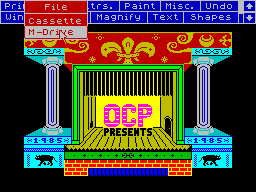Top Qs
Timeline
Chat
Perspective
OCP Art Studio
Raster graphics editor From Wikipedia, the free encyclopedia
Remove ads
OCP Art Studio or Art Studio was a popular bitmap graphics editor for home computers released in 1985, created by Oxford Computer Publishing and written by James Hutchby (original ZX Spectrum version).[1][2]
It featured a GUI with windows, icons, tools and pull-down menus that and could be controlled using an AMX Mouse.[1]
Some of the distinctive features include:
- Different pens, sprays and user-definable brushes
- An undo function
- Textured fills (with user-definable patterns including stipples, hatches, bricks, roof tiles, etc.)
- A font editor
- The drawing of geometrical shapes
Remove ads
Releases
The OCP Art Studio, also known simply as Art Studio, was released in 1985 for the ZX Spectrum and in 1986 for the Amstrad CPC and Commodore 64.[1][3][4][5]
The Advanced OCP Art Studio, also known as Advanced Art Studio, was released in 1986 for the ZX Spectrum 128K/+2 (developed by Dimitri Koveos), supporting the 128k memory models.[2][6] In 1987 ports for the Commodore 64, Amstrad CPC [7][8] and Atari ST (developed by Chris Hinsley) were released.[9][10][11]
Remove ads
Reception
Computer Gaming World in 1987 described OCP as "a versatile productivity tool ... a stunning and useful gift".[12]
Legacy
OCP Art Studio was frequently used for making graphics for home computer games in the early 1990s, and was used for games such as Gauntlet III: The Final Quest and CarVup.[13][14]
See also
References
Wikiwand - on
Seamless Wikipedia browsing. On steroids.
Remove ads

